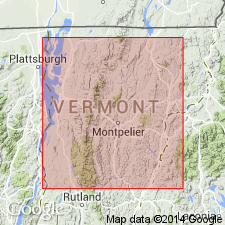
- Usage in publication:
-
- Heartwellville schist
- Modifications:
-
- Original reference
- Dominant lithology:
-
- Schist
- AAPG geologic province:
-
- New England province
Summary:
Pg. 278-283, 291, 293, 315, and map. Heartwellville schist. Mica schist. Grades into underlying Whitingham schist through transition zone 5 to 20 feet thick. Quartz and sericite, in varying proportions, make up 90 to 95 percent of the rock. Highly siliceous and highly micaceous layers can occur anywhere in the formation. Garnets of a red almandite type occur all through the formation. Is believed to be of sedimentary origin. Thickness is 300 to 1,200 feet. Is overlain by Readsboro schist, from which it is rather sharply separated but with no evidence of erosion. Identity of Greylock [Ordovician] and Heartwellville schists is well established, both by position and by mineral composition, structure, and texture.
Named for fact that town of Heartwellville, Bennington quadrangle, Bennington Co., southwestern VT, lies on a large area of the schist.
Source: US geologic names lexicon (USGS Bull. 896, p. 932-933).

- Usage in publication:
-
- Heartwellville schist
- Modifications:
-
- Age modified
- AAPG geologic province:
-
- New England province
Summary:
Table opp. p. 288. Heartwellville schist. Assigned this formation to Upper Cambrian, but without discussion.
Source: US geologic names lexicon (USGS Bull. 896, p. 932-933).
For more information, please contact Nancy Stamm, Geologic Names Committee Secretary.
Asterisk (*) indicates published by U.S. Geological Survey authors.
"No current usage" (†) implies that a name has been abandoned or has fallen into disuse. Former usage and, if known, replacement name given in parentheses ( ).
Slash (/) indicates name conflicts with nomenclatural guidelines (CSN, 1933; ACSN, 1961, 1970; NACSN, 1983, 2005, 2021). May be explained within brackets ([ ]).

